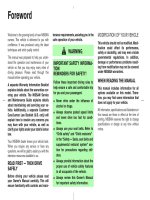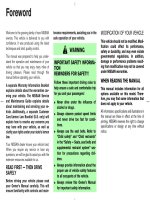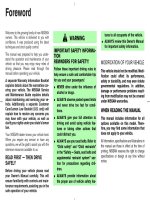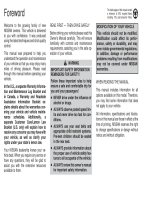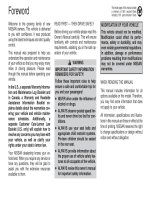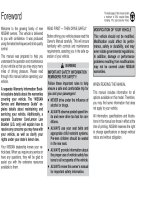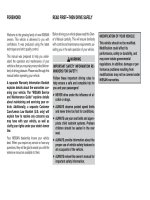Nissan Leaf 2014 owner manual - Sách hướng dẫn sử dụng xe Nissan Leaf đời 2014
Bạn đang xem bản rút gọn của tài liệu. Xem và tải ngay bản đầy đủ của tài liệu tại đây (9.53 MB, 396 trang )
For your safety, read carefully and keep in this vehicle.
OWNER'S MANUAL
2014 LEAF
2014 NISSAN LEAF ZE0-D
ZE0-D
Printing: August 2013 (10)
Publication No.: OM14E 0ZE0U0
Printed in USA
1509620cv1_EN_Leaf_OM_Cover.pdf 1 10/22/13 10:24 AM
Welcome to the growing family of new NISSAN
owners. This vehicle is delivered to you with
confidence. It was produced using the latest
techniques and strict quality control.
This manual was prepared to help you under-
stand the operation and maintenance of your
vehicle so that you may enjoy many miles of
driving pleasure. Please read through this manual
before operating your vehicle.
A separate Warranty Information Booklet
explains details about the warranties cov-
ering your vehicle. The NISSAN Service and
Maintenance Guide explains details about
maintaining and servicing your vehicle. Ad-
ditionally, a separate Customer Care/
Lemon Law Booklet (U.S. only) will explain
how to resolve any concerns you may have
with your vehicle, as well as clarify your
rights under your state’s lemon law.
In additional factory installed options, your ve-
hicle may also be equipped with additional ac-
cessories installed by NISSAN or by your
NISSAN certified LEAF dealer prior to delivery. It
is important that you familiarize yourself with all
disclosures, warnings, cautions, and instructions
concerning proper use of such accessories prior
to operating the vehicle and/or accessory. See a
NISSAN certified LEAF dealer for details con-
cerning the particular accessories with which
your vehicle is equipped.
Your NISSAN certified LEAF dealer knows your
vehicle best. When you require any service or
have any questions, we will be glad to assist you
with the extensive resources available to us.
READ FIRST — THEN DRIVE SAFELY
Before driving your vehicle, read your Owner’s
Manual carefully. This will ensure familiarity with
controls and maintenance requirements, assist-
ing you in the safe operation of your vehicle.
WARNING
IMPORTANT SAFETY INFORMATION RE-
MINDERS FOR SAFETY!
Follow these important driving rules to
help ensure a safe and comfortable trip
for you and your passengers!
• NEVER drive under the influence of
alcohol or drugs.
• ALWAYS observe posted speed limits
and never drive too fast for conditions.
• ALWAYS give your full attention to
driving and avoid using vehicle fea-
tures or taking other actions that could
distract you.
• ALWAYS use your seat belts and ap-
propriate child restraint systems. Pre-
teen children should be seated in the
rear seat.
• ALWAYS provide information about
the proper use of vehicle safety fea-
tures to all occupants of the vehicle.
• ALWAYS review this Owner’s Manual
for important safety information.
MODIFICATION OF YOUR VEHICLE
This vehicle should not be modified. Modi-
fication could affect its performance, safety
or durability, and may even violate govern-
mental regulations. In addition, damage or
performance problems resulting from
modification may not be covered under
NISSAN warranties.
WHEN READING THE MANUAL
This manual includes information for all features
and equipment available on this model. Features
and equipment in your vehicle may vary depend-
ing on model, trim level, options selected, order,
date of production, region or availability. There-
fore, you may find information about features or
equipment that are not included or installed on
your vehicle.
FOREWORD
All information, specifications and illustrations in
this manual are those in effect at the time of
printing. NISSAN reserves the right to change
specifications, performance, design or compo-
nent suppliers without notice and without obliga-
tion. From time to time, NISSAN may update or
revise this manual to provide Owners with the
most accurate information currently available.
Please carefully read and retain with this manual
all revision updates sent to you by NISSAN to
ensure you have access to accurate and up-to-
date information regarding your vehicle. Current
versions of vehicle Owner’s Manuals and any
updates can also be found in the Owner section
of the NISSAN website at
/>navigation/manualsGuide. If you have ques-
tions concerning any information in your Owner’s
Manual, contact NISSAN Consumer Affairs. See
the NISSAN CUSTOMER CARE PROGRAM
page in this Owner’s Manual for contact informa-
tionba.
IMPORTANT INFORMATION ABOUT
THIS MANUAL
You will see various symbols in this manual. They
are used in the following ways:
WARNING
This is used to indicate the presence of a
hazard that could cause death or serious
personal injury. To avoid or reduce the
risk, the procedures must be followed
precisely.
CAUTION
This is used to indicate the presence of a
hazard that could cause minor or moder-
ate personal injury or damage to your
vehicle. To avoid or reduce the risk, the
procedures must be followed carefully.
If you see the symbol above, it means “Do not do
this” or “Do not let this happen”.
If you see a symbol similar to those above in an
illustration, it means the arrow points to the front
of the vehicle.
Arrows in an illustration that are similar to those
above indicate movement or action.
Arrows in an illustration that are similar to those
above call attention to an item in the illustration.
[]:
Indicates a key/item displayed on the screen.
CALIFORNIA PROPOSITION 65
WARNING
WARNING
Certain vehicle components contain or
emit chemicals known to the State of
California to cause cancer and birth de-
fects or other reproductive harm. In addi-
tion, certain fluids contained in vehicles
and certain products of component wear
contain or emit chemicals known to the
State of California to cause cancer and
birth defects or other reproductive harm.
CALIFORNIA PERCHLORATE
ADVISORY
Some vehicle parts, such as lithium batter-
ies, may contain perchlorate material. The
following advisory is provided: “Perchlo-
rate Material - special handling may apply,
see www.dtsc.ca.gov/hazardouswaste/
perchlorate.”
Bluetooth® is a trademark
owned by Bluetooth SIG, Inc.
and licensed to Visteon.
SiriusXM Satellite Radio re-
quires subscription, sold
separately. Not available in
Alaska, Hawaii or Guam. For
more information, visit
www.siriusxm.com.
© 2013 NISSAN MOTOR CO., LTD.
All rights reserved. No part of this Owner’s
Manual may be reproduced or stored in a retrieval
system, or transmitted in any form, or by any
means, electronic, mechanical, photocopying,
recording or otherwise, without the prior written
permission of Nissan Motor Co., Ltd.
NISSAN CUSTOMER CARE PROGRAM
NISSAN CARES
Both NISSAN and your NISSAN certified LEAF dealer are dedicated to serving all your automotive needs. Your satisfaction with your vehicle and your
NISSAN certified LEAF dealer are our primary concerns. Your NISSAN certified LEAF dealer is always available to assist you with all your automobile sales
and service needs.
However, if there is something that your NISSAN
certified LEAF dealer cannot assist you with or
you would like to provide NISSAN directly with
comments or questions, please contact the
NISSAN Consumer Affairs Department using our
toll-free number:
For U.S. customers
1-877-NOGASEV
(1-877-664-2738)
For Canadian customers
1-800-387-0122
The Consumer Affairs Department will ask for the
following information:
• Your name, address, and telephone number
• Vehicle identification number (attached to the
top of the instrument panel on the driver’s side)
• Date of purchase
• Current odometer reading
• Your NISSAN certified LEAF dealer’s name
• Your comments or questions
OR
You can write to NISSAN with the information at:
For U.S. customers
Nissan North America, Inc.
Consumer Affairs Department
P.O. Box 685003
Franklin, TN 37068-5003
or via e-mail at:
For Canadian customers
Nissan Canada Inc.
5290 Orbitor Drive
Mississauga, Ontario L4W 4Z5
or via e-mail at:
information.centre@nissancanada. com
If you prefer, visit us at:
www.nissanusa.com (for U.S. customer) or
www.nissan.ca (for Canadian customers)
We appreciate your interest in NISSAN and
thank you for buying a quality NISSAN vehicle.
Table of
contents
Illustrated table of contents
EV Overview
Charging
Safety–Seats, seat belts and supplemental restraint system
Instruments and controls
Pre-driving checks and adjustments
Heater, air conditioner, audio and phone systems
Starting and driving
In case of emergency
Appearance and care
Maintenance and do-it yourself
Technical and consumer information
Index
0
EV
CH
1
2
3
4
5
6
7
8
9
10
0 Illustrated table of contents
Seats, seat belts and Supplemental Restraint System
(SRS) 0-2
Exterior front 0-3
Exterior rear 0-4
Passenger compartment 0-5
Cockpit 0-6
Instrument panel 0-8
Meters and gauges 0-9
Motor compartment 0-10
Warning and indicator lights 0-11
1. Rear head restraints/headrests (P 1-4)
2. Child restraint anchor points (for top tether
strap child restraint) (P 1-31)
3. Roof-mounted curtain side-impact supple-
mental air bags (P 1-35)
4. Seat belts (P 1-8)
5. Front head restraints/headrests (P 1-4)
6. Seat belt pretensioners (P 1-47)
7. Front seats (P 1-3)
8. Supplemental front-impact air bags (P 1-35)
9. LATCH (Lower Anchors and Tethers for
CHildren) system (P 1-19)
10. Rear seats (P 1-4)
11. Front seat-mounted side-impact supple-
mental air bags (P 1-35)
12. Occupant classification sensors (weight
sensors)
— Advanced Air Bag System (P 1-41)
13. Front passenger air bag status light
(P 2-20)
SEATS, SEAT BELTS AND
SUPPLEMENTAL RESTRAINT
SYSTEM (SRS)
0-2 Illustrated table of contents
1. Charge port lid (P 3-18)
2. Hood (P 3-16)
3. Headlight and turn signal lights
— Switch operation (P 2-43)
— Bulb replacement (P 8-22)
4. Windshield wiper and washer
— Switch operation (P 2-39)
— Blade replacement (P 8-13)
— Window washer fluid (P 8-11)
5. Side camera (if so equipped) (See LEAF
Navigation System Owner’s Manual.)
6. Outside mirrors (P 3-23)
7. Power windows (P 2-55)
8. License plate installation (P 9-9)
9. Front camera (if so equipped) (See LEAF
Navigation System Owner’s Manual.)
10. Recovery hook (P 6-14)
11. Fog lights*
— Switch operation (P 2-45)
— Bulb replacement (P 8-23)
12. Tires
— Wheels and tires (P 8-26, P. 9-6)
— Flat tire (P 6-3)
— Tire Pressure Monitoring System (TPMS)
(P 2-17, P. 5-2)
13. Doors
— Keys (P 3-2)
— Door locks (P 3-3)
— NISSAN Intelligent Key® system (P 3-6)
— Security system (P 2-36)
14. Child safety rear door lock (P 3-6)
EXTERIOR FRONT
Illustrated table of contents 0-3
1. Rear view camera* (See LEAF Navigation
System Owner’s Manual.)
2. Rear window wiper and washer
— Switch operation (P 2-41)
— Window washer fluid (P 8-11)
3. High-mounted stop light
— Bulb replacement (P 8-23)
4. Rear window defroster (P 2-42)
5. Solar cell module* (P EV-30)
6. Antenna (P 4-42)
— Satellite radio antenna (See LEAF Naviga-
tion System Owner’s Manual.)
7. Rear combination lights
— Bulb replacement (P 8-23)
8. Rear hatch (P 3-17)
— NISSAN Intelligent Key® system (P 3-6)
EXTERIOR REAR
0-4 Illustrated table of contents
1. Ceiling light (P 2-58)
2. Sun visors (P 3-20)
3. Map lights (P 2-58)
— Bluetooth® Hands-Free Phone System
microphone (See LEAF Navigation System
Owner’s Manual.)
4. Sunglasses holder (P 2-52)
5. Inside rearview mirror (P 3-21)
— HomeLink®* (if so equipped) (P 2-59)
6. Cargo area
— Cargo cover* (if so equipped) (P 2-53)
— EVSE (Electric Vehicle Supply Equipment)
(P CH-11)
7. Tools (P 6-12)
8. Heated seat switch (P 2-47)
9. Console box (P 2-53)
10. Door armrest
— Power window switch (P 2-55)
— Power door lock switch (P 3-5)
— Outside mirror remote control switch
(P 3-23)
11. Front cup holders (P 2-51)
PASSENGER COMPARTMENT
Illustrated table of contents 0-5
1. TRIP switch for twin trip odometer (P 2-6)
2. Trip computer switch (P 2-28)
3. Instrument brightness control switch
(P 2-42)
4. Headlight, fog light (if so equipped) and
turn signal switch
— Headlight (P 2-43)
— Turn signal light (P 2-45)
— Fog light (if so equipped) (P 2-45)
5. Steering-wheel-mounted controls (left side)
(See LEAF Navigation System Owner’s
Manual.)
—
Driving range button (if so
equipped)
— Audio control
— Bluetooth® Hands-Free Phone System
control
6. Steering wheel
— Power steering system (P 5-19)
— Horn (P 2-47)
— Driver’s supplemental air bag (P 1-35)
7. Wiper and washer switch (P 2-39)
8. Steering-wheel-mounted controls (right
side)
— Cruise control switches (P 5-15)
— ECO button (if so equipped) (P 2-47)
9. Fuse box cover (P 8-16)
10. Heated steering wheel (if so
equipped)(P 2-46)
11. Vehicle Dynamic Control (VDC) OFF
switch (P 2-49)
12. Charge timer OFF switch(P 2-50)
COCKPIT
0-6 Illustrated table of contents
13. Charge connector lock switch (P CH-18)
14. Charge port lid opener switch (P 2-49)
15. Tilting steering wheel lever (P 3-20)
16. Heated seat switch (P 2-47)
17. Shift lever (P 5-12)
18. Storage tray (P 2-51)
Illustrated table of contents 0-7
1. Side vents (P 4-6)
2. Meters and gauges (P 2-5)
3. Center multi-function control panel (See
LEAF Navigation System Owner’s Manual.)
— Navigation system
— Vehicle information and setting buttons
— Bluetooth® Hands-Free Phone System
— Audio system
4. Hazard warning flasher switch (P 6-2)
5. Center vents (P 4-6)
6. Rear window defroster switch (P 2-42)
7. Front passenger supplemental air bag
(P 1-35)
8. Hood release handle (P 3-16)
9. Power switch (P 5-7)
10. iPod® connector/USB connector (See
LEAF Navigation System Owner’s Manual.)
11. Power outlet (P 2-50)
12. Auxiliary input jack (See LEAF Navigation
System Owner’s Manual.)
13. Front passenger air bag status light/
(P 2-20)/Approaching Vehicle Sound for
Pedestrians (VSP) system warning light
(P 2-15)
14. Heater and air conditioner control (P 4-7)
15. Glove box (P 2-53)
INSTRUMENT PANEL
0-8 Illustrated table of contents
This vehicle is equipped with an upper display
and a lower display.
1. Master warning light (P 2-19)
2. ECO indicator (P 2-10)
3. Speedometer (P 2-6)
4. Clock (P 2-11)
5. Outside air temperature (P 2-10)
6. Turn signal/Hazard indicator light (P 2-22)
7. Li-ion battery temperature gauge (P 2-7)
8. Warning/indicator lights (P 2-13)
9. Power meter (P 2-7)
10. ECO indicator (P 2-10)
11. READY to drive indicator light (P 2-21)
12. Vehicle information display (P 2-23)
— Odometer/twin trip odometer (P 2-6)
— Trip computer (P 2-28)
— Shift “P” warning (if so equipped) (P 2-27)
— Indicator for timer (P 2-36)
13. Driving range (P 2-8)
14. Li-ion battery available charge gauge
(P 2-9)
15. Li-ion battery capacity level
gauge (P 2-10)
Upper display and lower display
METERS AND GAUGES
Illustrated table of contents 0-9
1. Brake fluid reservoir (P 8-10)
2. 12-volt battery (P 8-12)
3. Fuse/fusible link holder (P 8-16)
4. Fuse/fusible link holder (P 8-16)
5. Coolant tank cap (P 8-8)
6. Window washer fluid reservoir (P 8-11)
7. Fuse/fusible link holder (P 8-16)
MOTOR COMPARTMENT
0-10 Illustrated table of contents
Warning
light
Name Page
12-volt battery charge
warning light
2-14
Anti-lock Braking System
(ABS) warning light
2-15
Approaching Vehicle
Sound for Pedestrians
(VSP) system warning
light
2-15
BRAKE system warning
light (yellow)
2-15
BRAKE warning light (red) 2-16
Electric shift control sys-
tem warning light
2-17
Warning
light
Name Page
EV system warning light 2-17
Headlight warning light 2-17
Low battery charge warn-
ing light
2-17
Low tire pressure warning
light
2-17
Master warning light (red/
yellow)
2-19
Power steering warning
light
2-19
Seat belt warning light 2-19
Warning
light
Name Page
Supplemental air bag
warning light
2-19
Vehicle Dynamic Control
(VDC) warning light
2-20
WARNING AND INDICATOR LIGHTS
Illustrated table of contents 0-11
Indicator
light
Name Page
Exterior light indicator 2-20
Front fog light indicator
light (if so equipped)
2-20
Front passenger air bag
status light
2-20
High beam indicator light
(blue)
2-21
Plug in indicator light 2-21
Power limitation indicator
light
2-21
READY to drive indicator
light
2-21
Security indicator light 2-22
Indicator
light
Name Page
Turn signal/hazard indica-
tor lights
2-22
Vehicle Dynamic Control
(VDC) off indicator light
2-22
0-12 Illustrated table of contents
EV Overview
The EV (Electric Vehicle) system EV-2
Li-ion battery EV-2
Driving with a discharged Li-ion battery EV-3
Charging the 12-volt battery EV-5
Li-ion battery warmer EV-5
High voltage precautions EV-7
High-voltage components EV-7
Road accident precautions EV-8
Emergency shut-off system EV-9
EV (Electric Vehicle) characteristics EV-9
Noise and vibration EV-10
Life with an EV (scene guide) EV-10
Charging the Li-ion battery EV-10
Before driving your vehicle (models with
navigation system) EV-13
Starting your vehicle EV-17
Driving the vehicle EV-18
At home after driving EV-22
Efficient use of your vehicle EV-23
Range EV-23
Improve driving range EV-23
Li-ion battery life EV-24
Li-ion battery maintenance EV-25
EV unique information EV-25
Meters and indicators EV-25
Approaching Vehicle Sound for Pedestrians
(VSP) system EV-28
Electric shift control system EV-29
LED headlight (low beam) (if so equipped) . . . .EV-29
Solar cell module (if so equipped) EV-30
Driving range button (if so equipped) EV-30
The LEAF is an electric vehicle. Some of the
vehicle’s systems operate differently and have
different operating characteristics than vehicles
equipped with an internal combustion engine. It is
important to carefully review the entire Owner’s
Manual for this reason. The main difference is the
LEAF is powered by electricity. The LEAF does
not require and it is not capable of using gasoline
like a vehicle powered by a traditional internal
combustion engine. The LEAF uses electricity
stored in the lithium ion (Li-ion) battery. The ve-
hicle Li-ion battery must be charged with electric-
ity before the vehicle can be driven. As the vehicle
operates, the Li-ion battery gradually discharges.
If the Li-ion battery becomes completely dis-
charged, the vehicle will not operate until it is
re-charged. The charging process usually takes
from approximately 30 minutes to 21 hours as
described more fully in this manual.
This vehicle uses two types of batteries. One is
the 12-volt battery that is the same as the battery
in vehicles powered by gasoline engines, the
other is the Li-ion battery (high voltage).
The 12-volt battery provides power to the vehicle
systems and features such as the audio system,
supplemental restraint systems, headlights and
windshield wipers.
The Li-ion battery provides power to the electric
motor (traction motor) that moves the vehicle.
The Li-ion battery also charges the 12-volt bat-
tery.
The vehicle must be plugged in for the Li-ion
battery to be charged. Additionally, the vehicle
system can extend the vehicle range by convert-
ing driving force into electricity that is stored in
the Li-ion battery while the vehicle is decelerating
or being driven downhill. This is called regenera-
tive brake. This vehicle is considered to be an
environmentally friendly vehicle because it does
not emit exhaust gases, such as carbon dioxide
and nitrogen oxide.
WARNING
Your vehicle contains a sealed Li-ion high
voltage battery. If the Li-ion battery is
disposed of improperly, there is a risk of
severe burns and electrical shock that
may result in serious injury or death and
there is also a risk of environmental dam-
age.
CAUTION
To prevent damage to the Li-ion battery:
• Do not expose a vehicle to extreme
ambient temperatures for extended
periods.
• Do not store a vehicle in temperatures
below −13°F (−25°C) for over seven
days.
• Do not leave your vehicle for over 14
days where the Li-ion battery available
charge gauge reaches a zero or near
zero (state of charge).
• Do not use the Li-ion battery for any
other purpose.
THE EV (ELECTRIC VEHICLE)
SYSTEM LI-ION BATTERY
EV-2 EV Overview
NOTE:
• If the outside temperature is −13°F
(−25°C) or less, the Li-ion battery may
freeze and it cannot be charged or provide
power to run the vehicle. Move the vehicle
to a warm location.
• The capacity of the Li-ion battery in your
vehicle to hold a charge will, like all such
batteries, decrease with time and usage.
As the battery ages and capacity de-
creases, this will result in a decrease from
the vehicle’s initial mileage range. This is
normal, expected, and not indicative of
any defect in your Li-ion battery. NISSAN
estimates that battery capacity will be ap-
proximately 80% of original capacity after
five years, although this is only an esti-
mate, and this percentage may vary (and
could be significantly lower) depending
on individual vehicle and Li-ion battery
usage.
• The Li-ion battery has limited service life,
and when its charging capacity falls below
a specific level, the EV system warning
light will illuminate. Owners should bring
their vehicle in for inspection and possible
battery replacement.
• The Li-ion battery has a limited service
life. Contact a NISSAN certified LEAF
dealer for information about recycling or
disposal of the Li-ion battery. Do not at-
tempt to recycle or dispose of the Li-ion
battery yourself.
DRIVING WITH A DISCHARGED
LI-ION BATTERY
When a destination is set in the navigation sys-
tem that exceeds the available vehicle range, the
navigation system automatically searches the lo-
cation of nearby charging stations. When the
nearby charging station locations are displayed,
charge the Li-ion battery as soon as possible
(models with navigation system).
Warning lights illuminate on the instrument panel
and messages are displayed on the vehicle infor-
mation display to inform you that the Li-ion bat-
tery charge is low. Instructions are also displayed
on the navigation system screen to direct you to
nearby charging stations (models with navigation
system).
The vehicle’s range is very limited when these
warning lights illuminate and messages are dis-
played. Follow the instructions on the navigation
screen (models with navigation system) and im-
mediately charge the vehicle at the nearest
charging station.
EV Overview EV-3
There are three levels of information that will be
displayed as the Li-ion battery becomes dis-
charged:
1. The following warning lights illuminate on the
instrument panel and messages are displayed
on the vehicle information display at the same
time to indicate low Li-ion battery charge:
• The low battery charge warning light
• The master warning light
• “Li-ion battery level is Low” warning message
is displayed on the vehicle information dis-
play
• See “Li-ion battery low charge warning” in
the “Instruments and controls” section.
• Messages are displayed on navigation sys-
tem screen (if so equipped)
• See “Low battery warning” in the “Instru-
ments and controls” section.
• The driving range flashes
᭺
1
.
NOTE:
Due to traffic conditions, it may be diffi-
cult to get to the charging station sug-
gested by the navigation system. If the
Li-ion battery is almost completely dis-
charged, drive directly to the nearest
charging station (models with naviga-
tion system).
2. If the vehicle is driven and the Li-ion battery
continues to discharge, the driving range on
the instrument panel changes to “ ”
᭺
2
.
Messages are displayed on the Navigation
System screen (if so equipped). For more
information, see “Low battery warning” in the
“Instruments and controls” section.
3. When the power limitation indicator light
illuminates, traction motor output is lim-
ited resulting in reduced vehicle speed. Stop
the vehicle in a safe location before the Li-ion
battery becomes completely discharged and
EV-4 EV Overview
there is no power available to drive the ve-
hicle. Contact Roadside assistance service
shown in your NISSAN Warranty Information
Booklet. See “If the Li-ion battery becomes
completely discharged” in the “In case of
emergency” section.
CHARGING THE 12-VOLT BATTERY
The 12-volt battery is charged automatically us-
ing electricity stored in the Li-ion battery.
When the 12-volt battery is being charged, the
charge status indicator light on the instrument
panel flashes. (except when charging the Li-ion
battery or the power switch is in the READY to
drive position.) See “Charge status indicator
light” in the “Charge” section.
While vehicle is driven
The Li-ion battery charges the 12-volt battery as
necessary when the power switch is in the
READY to drive position or ON position.
The 12-volt battery is not charged in the following
conditions.
• When the power switch is in ACC position.
• When the power switch is in ON position and
shift position is in the N (Neutal) position.
While the vehicle is not in use
When the EV (Electric Vehicle) system is off for
an extended time, the 12-volt battery may be
automatically charged for a short period of time
on a regular basis.
LI-ION BATTERY WARMER
CAUTION
The Li-ion battery warmer does not oper-
ate if the available Li-ion battery charge
is less than approximately 30% and the
charger is not connected to the vehicle.
To help prevent the Li-ion battery from
freezing, do not leave the vehicle in an
environment if temperatures may go be-
low -1°F (-17°C) unless the vehicle is con-
nected to a charger.
The Li-ion battery warmer helps to prevent the
Li-ion battery from freezing and helps to prevent
significant reductions in the Li-ion battery output
when the temperature is cold. The Li-ion battery
warmer automatically turns on when the Li-ion
battery temperature is approximately -1°F
(-17°C) or colder. The Li-ion battery warmer au-
tomatically turns off when the Li-ion battery tem-
perture is approximately 14°F (-10°C) or higher.
The Li-ion battery warmer uses electrical power
from an external source when a charger is con-
nected to the vehicle. The Li-ion battery warmer
uses electrical power from the Li-ion battery
when the charger is not connected to the vehicle.
NOTE:
• Connect the charger to the vehicle and
place the power switch in the OFF posi-
tion when parking the vehicle if tempera-
tures may go below -1°F (-17°C). This pro-
vides external power to the Li-ion battery
warmer when it operates and does not
discharge the Li-ion battery.
• The charging status indicator lights illumi-
nate in a specific pattern when the Li-ion
battery warmer operates. The charging
status indicator lights use the same pat-
tern to indicate 12-volt battery charging,
Climate Ctrl. Timer operation or Remote
Climate Control operation (models with
navigation system). The charging status
indicator lights do not change if the Li-ion
battery warmer operates at the same time
as the above features. See “Charge status
indicator light” in the “Charging” section.
EV Overview EV-5
• The Li-ion battery warmer uses Li-ion bat-
tery power to operate, even if the vehicle
is connected to a charger when:
– the vehicle’s power switch is in the ON
position.
– there is no electrical power being sup-
plied to the charging equipment.
• When the Li-ion battery warmer is already
in operation using an external power
source, it will continue to use the external
power even if the power switch is placed
in the ON position.
• Vehicle driving range is reduced if the
Li-ion battery warmer operates (Li-ion
battery temperature approximately -1°F
(-17°C) or colder) while driving the vehicle.
You may need to charge the Li-ion battery
sooner than in warmer temperatures.
• The Li-ion battery requires more time to
charge when the Li-ion battery warmer
operates.
• The predicted charging time displayed on
the meter and navigation system (models
with navigation system) increases when
the Li-ion battery warmer operates.
• Climate control performance is reduced
when using the Climate Ctrl. Timer or Re-
mote Climate Control (models with navi-
gation system) while the Li-ion battery
warmer operates.
• The Li-ion battery may not charge to the
expected level using the charging timer
when [Start Time] (models with navigation
system) and [End Time] are set while the
Li-ion battery warmer operates.
• Set the charging timer [End Time] when
charging in cold weather. The vehicle au-
tomatically determines when to start
charging to fully charge the Li-ion battery,
even if the Li-ion battery warmer operates.
Charging ends before the set end time if
the Li-ion battery is fully charged.
EV-6 EV Overview

